When navigating the intricacies of Stochastic Oscillator signals, it's essential to grasp the nuances beyond just the surface levels.
By honing in on the subtle shifts and patterns within the oscillator's movements, you can potentially unlock a deeper understanding of market dynamics.
These 10 tips offer a roadmap to deciphering these signals effectively, providing you with a strategic advantage in your trading endeavors.
Unlock the full potential of the Stochastic Oscillator by mastering these key insights and elevating your trading game to the next level.
Stochastic Oscillator Basics
Stochastic Oscillator Basics can be understood as a technical analysis tool developed by George C. Lane in the 1950s to compare recent closing prices with a specified period's range. This indicator, often referred to as a momentum oscillator, helps traders assess the strength and direction of a trend.
By calculating the percentage difference between the most recent closing price and the high-low range over a set period, the Stochastic Oscillator provides valuable insights into market conditions. It's commonly used to identify overbought and oversold levels, indicating potential reversal points in the market.
Understanding these basics is crucial for interpreting the signals generated by the Stochastic Oscillator accurately and making informed trading decisions based on market momentum.
Interpreting %K and %D
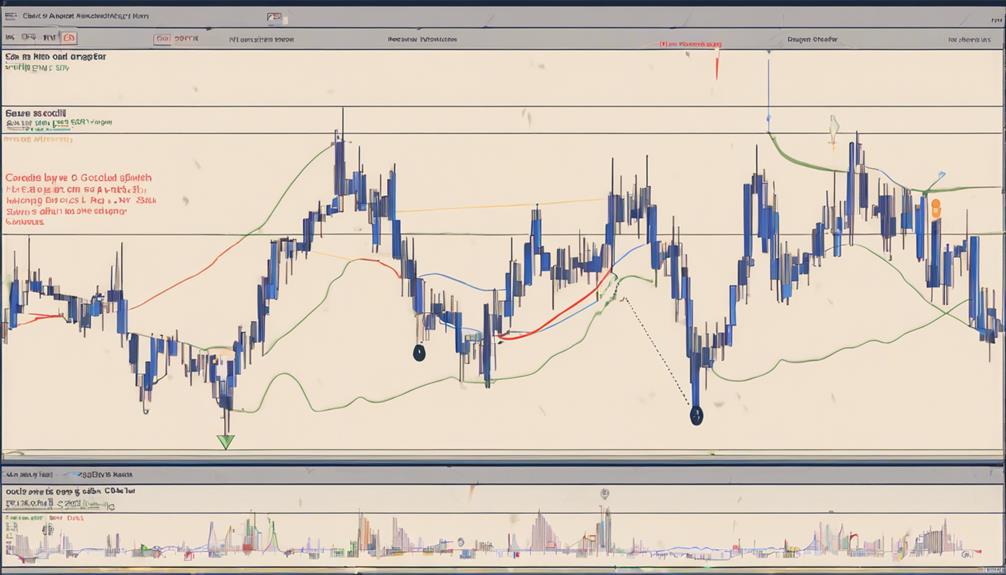
When analyzing %K and %D, remember that %K signals bullish or bearish conditions based on price positioning, while %D serves to confirm trend direction through its moving average calculation.
Pay close attention to crosses between %K and %D lines, as they indicate potential shifts in momentum and suggest actionable trading opportunities.
The relationship and movements of these lines offer valuable insights into market sentiment, helping traders anticipate reversals and trends with more precision.
K Signals Bullish/Bearish
To interpret %K and %D signals for bullish or bearish trends, traders closely monitor the crossover dynamics between these two indicators. %K crossing above %D signals a bullish trend, presenting potential buying opportunities for traders.
Conversely, when %K crosses below %D, it indicates a bearish trend, signaling potential selling points. The convergence of %K and %D lines can validate trend strength, offering actionable insights.
On the other hand, a divergence between %K and %D may suggest a weakening trend or an upcoming reversal in the market. By observing crossovers and divergences in %K and %D, traders can gain valuable information to make informed decisions in response to the dynamic nature of the market.
D Confirms Trend Direction
Utilizing the 3-day simple moving average of %K, %D serves as a crucial signal line for confirming trend direction with enhanced clarity.
The %D line is pivotal in determining the strength and direction of trends in the market. When %K crosses above %D, it indicates a potential bullish trend, signaling a buying opportunity.
Conversely, when %K crosses below %D, it suggests a potential bearish trend, indicating a time to consider selling.
Crossings Indicate Momentum Shifts
Analyzing the intersections of the %K and %D lines provides crucial insights into momentum shifts within the market. When the Stochastic %K crosses above the %D line, it signals a bullish momentum shift, indicating a potential uptrend.
Conversely, if the %K line crosses below the %D line, it suggests a bearish momentum shift, pointing towards a possible downtrend. These crossings between the Stochastic %K and %D lines are instrumental in identifying trend reversals and changes in price momentum.
Traders often use these intersections to pinpoint entry and exit points in their trading strategies, leveraging the information provided by the Stochastic oscillator to make informed decisions and capitalize on market movements efficiently.
Identifying Overbought Conditions
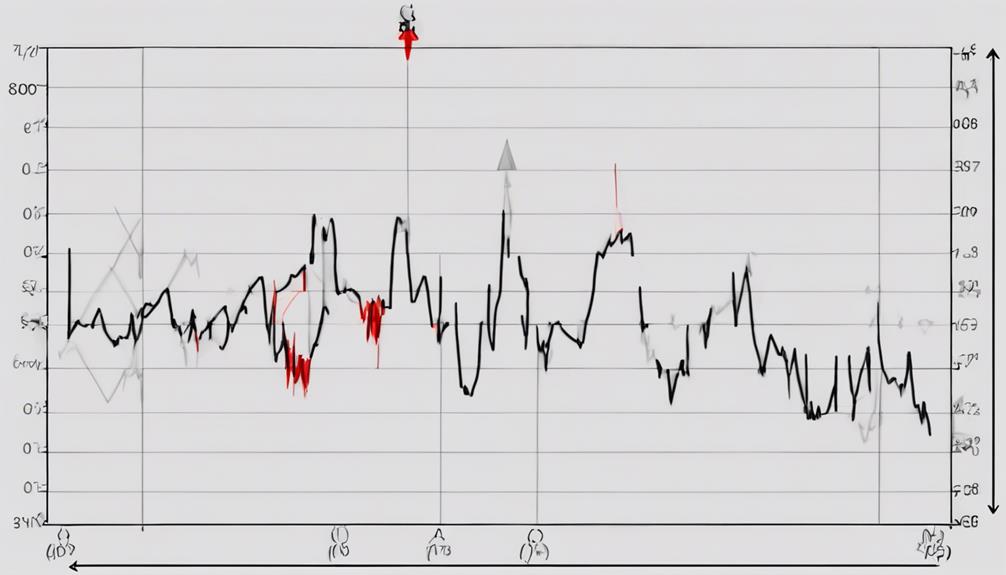
When the Stochastic Oscillator rises above 80, it indicates overbought conditions. This suggests that the price might be at unsustainable highs, possibly signaling a reversal.
Traders often seek divergence to confirm these conditions, helping anticipate selling opportunities.
Overbought Signal Definition
To identify overbought conditions in the Stochastic Oscillator, focus on when the indicator rises above the 80 level. When the Stochastic Oscillator reaches this level, it indicates that the asset's price might've peaked at an unsustainable high, potentially signaling a reversal. Here are key points to consider regarding overbought signals:
- Overbought signals suggest caution and the possibility of trend shifts.
- Traders often view this signal as an opportunity to consider selling or taking profits.
- It's essential to understand that overbought conditions don't guarantee an immediate reversal.
- Monitoring overbought signals helps traders make informed decisions and navigate market dynamics effectively.
Indicator Threshold Levels
After identifying overbought conditions in the Stochastic Oscillator as the indicator rises above the 80 level, understanding indicator threshold levels becomes crucial in pinpointing potential reversals in asset prices.
When the Stochastic Oscillator surpasses the 80 threshold level, it indicates that the asset may be overvalued, signaling a possible price correction. Traders often interpret this as selling opportunities, anticipating a price reversal or pullback.
By monitoring sustained readings above 80, traders can identify entry points for short positions, aiming to capitalize on potential downward price movements.
Recognizing these overbought conditions and the significance of the 80 threshold level is essential for traders seeking to make informed decisions based on the Stochastic Oscillator signals.
Avoiding False Signals
To enhance accuracy in identifying overbought conditions while using the Stochastic Oscillator, it's crucial to be vigilant for potential false signals, especially in choppy or sideways markets where accuracy may be compromised. When trading and analyzing Stochastic Oscillator signals, consider the following:
- Look for confirmation from other indicators or price action to validate overbought signals.
- Understand market context and trend strength to differentiate true overbought conditions from temporary spikes.
- Be cautious in choppy markets where false signals are more likely to occur.
- Combine Stochastic Oscillator signals with trend analysis to reduce the risk of misinterpreting overbought readings.
Recognizing Oversold Conditions
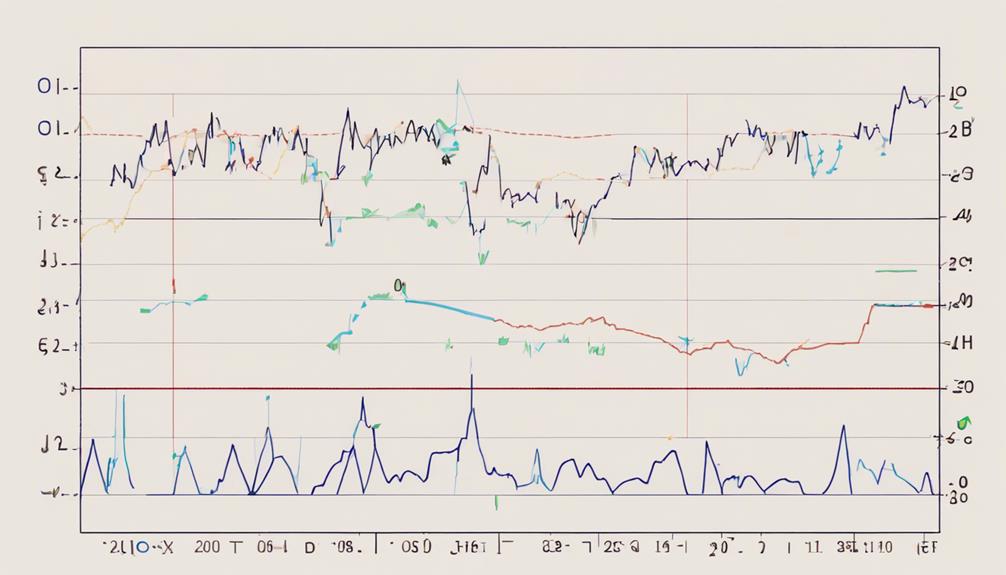
Recognizing oversold conditions in the market indicates potential buying opportunities for traders when the stochastic oscillator falls below 20. The stochastic oscillator, an indicator used to identify overbought and oversold conditions, signals that a security has been oversold when it reaches below the 20 level. This occurrence suggests a potential price reversal, making it an attractive opportunity for traders looking for market entry points.
While oversold conditions don't guarantee an immediate price increase, they often precede a temporary price dip, prompting traders to consider buying opportunities. Understanding these conditions equips traders with valuable insights for making informed decisions in the market, aiding in the identification of potential turning points in price movements.
Understanding Signal Crossovers
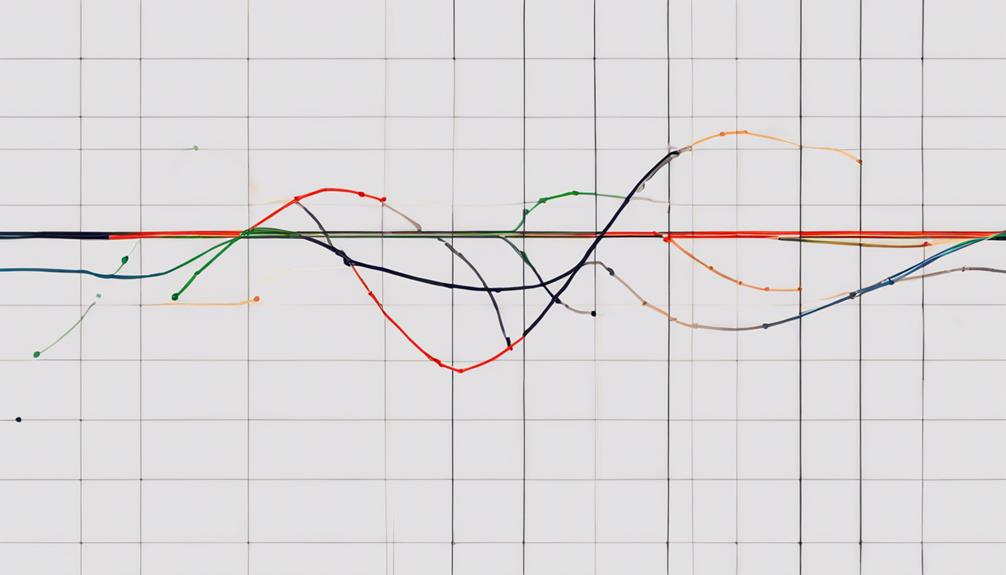
When analyzing stochastic oscillator signals, signal crossovers play a crucial role in identifying potential trend reversals. Here are some key insights about signal crossovers on the stochastic oscillator chart:
- Signal crossovers happen when the %K line crosses the %D line.
- A bullish signal occurs when the %K line moves above the %D line.
- A bearish signal is generated when the %K line moves below the %D line.
- Traders often rely on signal crossovers to confirm possible trend reversals. The timing of these crossovers can offer valuable insights into market momentum shifts.
Using Divergence for Insights
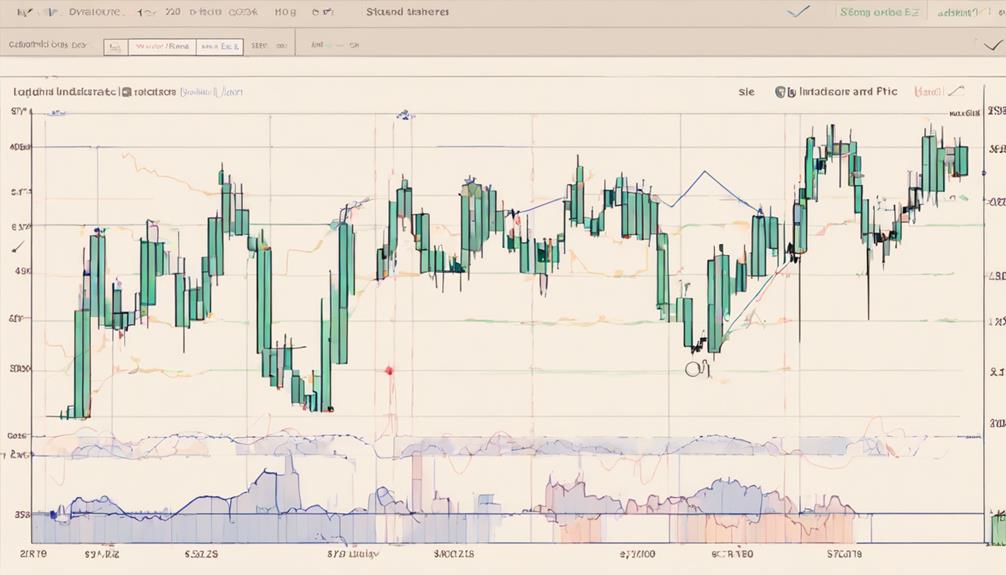
Utilizing divergence analysis in Stochastic Oscillator signals provides traders with essential insights into potential market reversals and trend changes. Divergence occurs when the price trend and oscillator trend move in opposite directions.
Bullish divergence, characterized by lower price lows and higher oscillator lows, suggests a possible upward reversal. On the other hand, bearish divergence, where higher price highs align with lower oscillator highs, indicates a potential downward reversal.
Incorporating Trend Analysis
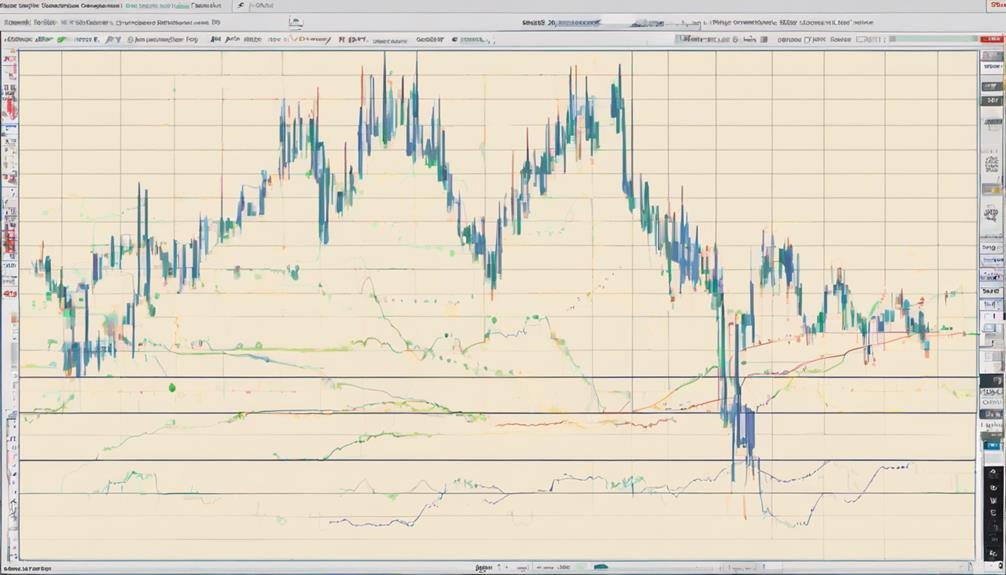
To improve trading decisions with Stochastic Oscillator signals, incorporating trend analysis is essential for identifying market direction and strength efficiently. When analyzing trends alongside Stochastic Oscillator signals, you gain a comprehensive view of the market movements. Here are some key points to consider:
- Determine if the market is in an uptrend, downtrend, or range-bound.
- Confirm Stochastic Oscillator signals by aligning with the prevailing trend direction.
- Use trend analysis to enhance the accuracy of entry and exit points.
- Understand the overall market movement for making well-informed trading decisions.
Setting Stop-Loss and Take-Profit Levels
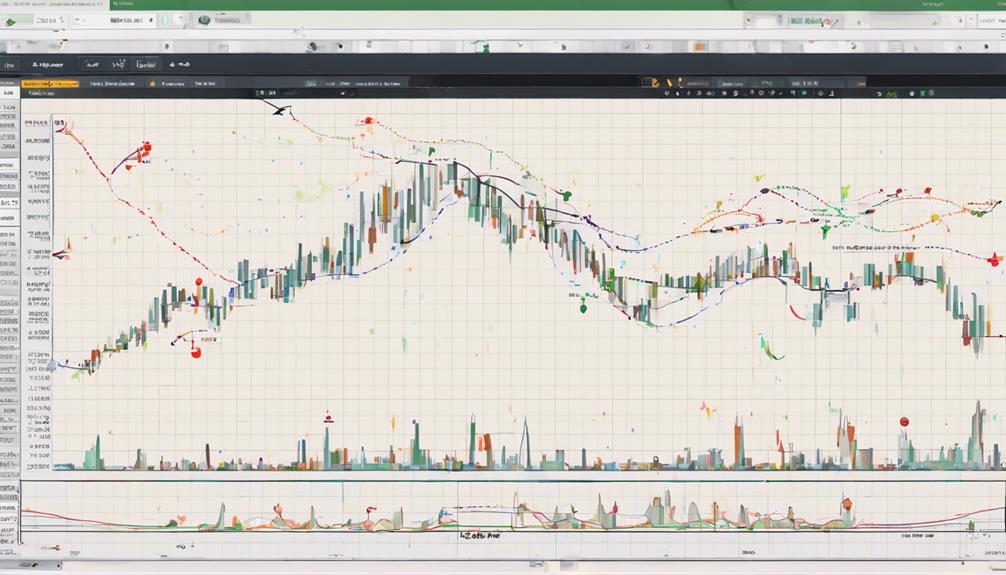
When setting stop-loss and take-profit levels using the stochastic oscillator, it's crucial to align them with the oscillator's overbought and oversold readings.
Consider historical support and resistance levels when determining your take-profit targets in conjunction with stochastic signals.
Utilize trailing stop-loss orders to secure profits as the market moves favorably, guided by the stochastic oscillator's insights.
Stop-Loss Importance
Setting precise stop-loss and take-profit levels based on Stochastic Oscillator signals is fundamental for effective risk management in trading. When managing risk and protecting capital, consider the following:
- Maximize Gain-Loss Ratio: Adjust stop-loss levels to ensure potential losses are smaller than potential gains.
- Consider Volatility: Set stop-loss levels based on market volatility to avoid premature exits.
- Review Risk-Reward Ratio: Align take-profit levels with stop-loss levels to maintain a favorable risk-reward ratio.
- Reevaluate Periodically: Regularly reassess and adjust stop-loss and take-profit levels as market conditions change.
These strategies will help you navigate the complexities of trading with Stochastic Oscillator signals while safeguarding your capital and optimizing your trading outcomes.
Take-Profit Strategies
Effectively determining take-profit levels is a critical aspect of establishing robust risk management strategies in trading. Setting take-profit levels allows you to secure profits by closing positions at predefined price points.
By incorporating stop-loss and take-profit levels, traders can maintain a favorable risk-reward ratio where potential gains exceed potential losses. Planning these levels before entering a trade helps you manage risk effectively and uphold trading discipline.
Implementing secure take-profit strategies is fundamental for successful trading and overall risk management. Remember, combining stop-loss and take-profit levels with a clear risk-reward ratio forms the cornerstone of effective trading strategies, ensuring that you can both limit losses and secure profits in the dynamic financial markets.
Risk Management Techniques
Utilizing strategic placement of stop-loss and take-profit levels is essential in managing risks effectively during trading activities. When setting up your risk management techniques, consider the following:
- Setting stop-loss levels: Exit a trade if the price moves against your position to limit potential losses.
- Take-profit levels: Lock in profits by strategically placing targets for when the price reaches a certain level.
- Risk-reward ratio: Balance potential losses with expected gains for better risk management.
- Using technical indicators: Determine optimal stop-loss and take-profit positions based on support and resistance levels.
Implementing a disciplined approach to setting these levels is crucial for consistent risk management and establishing a solid exit strategy based on trading signals.
Applying Stochastic Oscillator in Trading Strategies
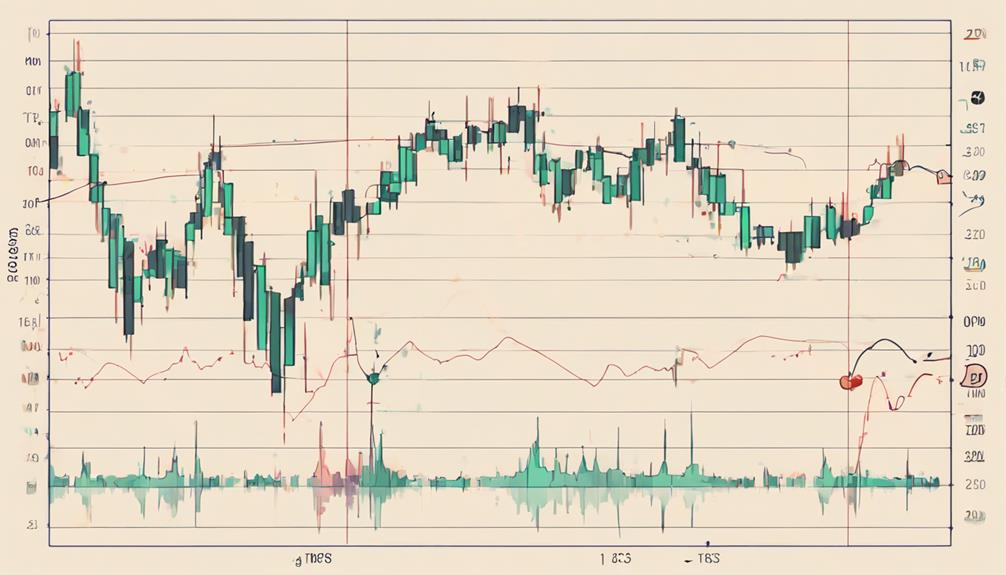
When incorporating the Stochastic Oscillator into your trading strategies, identifying overbought and oversold conditions becomes essential for pinpointing potential entry and exit points. By utilizing this technical indicator, traders can anticipate trend reversals and market shifts, enhancing decision-making processes.
Analyzing divergences between price action and oscillator readings can offer valuable insights. Understanding how crossovers and signal line interactions work can help in identifying buy or sell opportunities. Incorporating the Stochastic Oscillator into your trading strategies enables you to gauge market sentiment effectively, making informed decisions based on momentum and trend analysis.
Monitoring Stochastic Oscillator for Confirmation
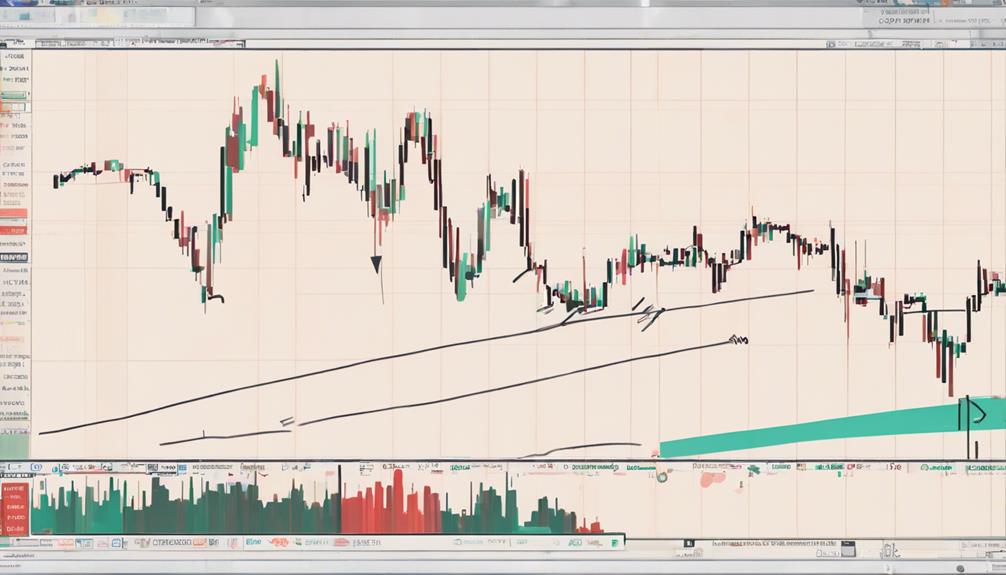
For enhanced confirmation when monitoring the Stochastic Oscillator, observe crossovers between the %K and %D lines.
- Check for bullish signals when the %K line crosses above the %D line, indicating potential buying opportunities.
- Identify bearish signals when the %K line crosses below the %D line, signaling possible selling opportunities.
- Utilize the Stochastic Oscillator to validate trends and confirm market shifts for improved decision-making.
- Pay attention to the spacing between the %K and %D lines to strengthen the confirmation of price movements.
What Are the Key Tips for Decoding Stochastic Oscillator Signals?
To decode stochastic oscillator signals efficiently, traders should apply the best stochastic oscillator methods. Firstly, identify oversold and overbought levels for potential reversal signals. Secondly, use signal line crossovers for entry and exit points. Lastly, consider divergence between price and stochastic oscillator for insightful trend reversal indications.
Frequently Asked Questions
How Do You Interpret the Stochastic Oscillator?
To interpret the stochastic oscillator, watch for overbought levels above 80 and oversold levels below 20. Monitor changes for potential trend shifts. The intersection of the oscillator and its moving average can indicate market reversals. Divergence signals potential trend changes.
How to Read Stochastic Fast?
To read Stochastic Fast, watch how it zips, like a speedometer in a race, gauging short-term market speed. Its swift reactions show sudden shifts, but be wary of the noise. Learn to surf its waves for timely decisions.
How Do You Analyze a Stochastic Indicator?
To analyze the stochastic indicator, identify overbought conditions above 80 and oversold conditions below 20. Watch for readings above 50 in the upper trading range and below 50 in the lower range. Look for divergences and use %K/%D line crossovers for buy/sell signals.
What Are the Settings for a 5-3-3 Stochastic Indicator?
In a 5-3-3 Stochastic Indicator, the settings involve a 5-day lookback period for %K calculation based on recent closing prices. %D is a 3-day SMA of %K, offering smoother signals. Adjust settings to suit your trading style and current market conditions.
Conclusion
In conclusion, mastering the art of decoding Stochastic Oscillator signals is essential for successful trading. By understanding the oscillators' range, overbought and oversold conditions, signal crossovers, and trend analysis, you can make informed decisions.
Remember, 'patience is a virtue' when it comes to analyzing market signals. Keep honing your skills and stay disciplined in your trading approach to maximize profits and minimize losses.


